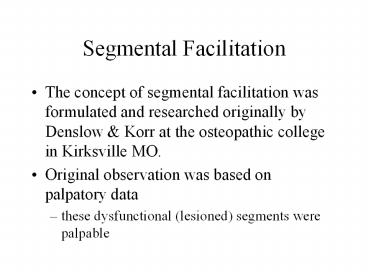Segmental Facilitation - PowerPoint PPT Presentation
1 / 6
Title:
Segmental Facilitation
Description:
decreases galvanic skin resistance associated with increased sweat gland activity ... Galvanic skin resistance (SNS) Sweat gland activity (SNS) EMG (skeletal muscle) ... – PowerPoint PPT presentation
Number of Views:17
Avg rating:3.0/5.0
Title: Segmental Facilitation
1
Segmental Facilitation
- The concept of segmental facilitation was
formulated and researched originally by Denslow
Korr at the osteopathic college in Kirksville MO. - Original observation was based on palpatory data
- these dysfunctional (lesioned) segments were
palpable
2
Segmental Facilitation
- Normal vertebrae
- When pressure was applied to the spinous
processes, up to 7 Kg of pressure would elicit a
minimal response in the adjacent paraspinal
muscles - Abnormal vertebrae
- Much lower pressure (1-3 Kg) would elicit an
exaggerated response in the adjacent paraspinal
muscles
3
Segmental facilitation
- In addition exaggerated responses in the adjacent
paraspinal muscles to the lesioned segment could
be observed when decreased pressure was applied
to normal spinous processes at levels above or
below the lesioned segment without that level
responding. (key finding)
4
Segmental facilitation
- Lesioned segments shows both exaggerated ventral
horn activity, but also intermediolateral horn
activity, which is the site of preganglionic SNS
neurons. (C8-L3) - Additional studies confirmed the presence of
sympathicotonia (hyperactivity of the SNS) at the
level of the segmental facilitation - decreases galvanic skin resistance associated
with increased sweat gland activity
5
Segmental facilitation-end points
- Red reaction (SNS)
- Galvanic skin resistance (SNS)
- Sweat gland activity (SNS)
- EMG (skeletal muscle)
6
Segmental facilitation
- Clinical significance
- The facilitated segment acts as a focusing lens
and bombards its targets with an exaggerated
neural traffic. - This increased neural segment outflow can result
from any increased cord traffic either afferent
or efferent - results in increased local muscle spasm and
hyperactive SNS activity - Long term effects may result in premature
dysfunction of tissues or organs as the tissue
tries to override the effects of increased SNS
activity































